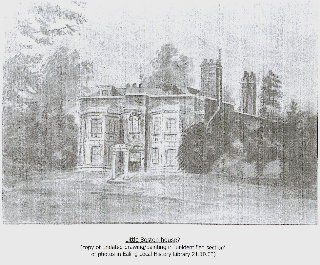Little Boston Yields its Secrets
One of the most fascinating aspects to be revealed in 'Little Ealing a walk through history' was that John Quincy Adams, a future American president, lived in Little Ealing for a short period in the early 19th century. Whilst Adams was American minister to Britain from 1815 to 1817, he and his family lived at Little Boston, a house that was situated on the northern corner of the Ride and Windmill Road on the borders of Brentford and Ealing. Little Boston House at that time formed part of the lands of Boston Manor which were owned by the Clitherow family from 1670 until the 1920s. It appears on the John Rocque map of 1746 (the first detailed map of the area) and on subsequent parish and ordnance survey maps until the 1920s.

From 1923 the Clitherow family had begun to sell off the manor estates; Boston Manor house and the immediate parkland was sold to Brentford Council, what is now part of Blondin Park was sold to Ealing Council and other parts of the estate were sold to private developers for housing development. From what we had learnt from older residents and word of mouth, Little Boston house had been acquired at this time by a builder called Jackman who subsequently demolished the house and built the present houses in Windmill Road on the site. One of these, 236 Windmill Road on the corner of the Ride appears to be on the site of the 'old' Little Boston House and is itself called Little Boston.
Old Little Boston House remained something of a mystery to us. There were only two photos we were able to locate, both at Ealing Local History Library, and which were included in the book. These were a very faded small photo of the house in the distance from Windmill Road which we would thought would have been taken in the 1920s and a photo of the Brentford 'Beating of the Bounds' of about 1900 on the corner of the Ride where the side of the house is just visible in the background. The fact that the house was on the boundaries of the old parishes and then boroughs of Ealing and Brentford and from time to time was in each made research into who lived there difficult.

Little Boston House
Obviously Little Boston House was a significant house in relation to the Boston Manor estate. The Ride (or Colonel's Drive as it was also known – after Colonel Clitherow) was, until the 1920s, a private road and would have been the original driveway up to Boston Manor House from Ealing. Early 20th century photos show the Ride still with a gate across the entrance from Windmill Road. From its position therefore, one might deduce Little Boston was a lodge house for the estate. However the house seemed too large and in fact there was a smaller house called Boston Lodge on the opposite side of the Ride. Boston Lodge appears to have been built in the mid-19 th century and survived until the 1970s (latterly as a Territorial Army headquarters) when it was demolished for the building of Gunnersbury Roman Catholic Boys School.
The occupancy of Little Boston in the early 19th century led us to conclude that Little Boston was probably used as the 'dower house' for Boston Manor. A dower house (which derives from the old custom of the marriage dowry) was typically made available to the widow of the lord of the manor when the eldest son inherited the manor house. However in practice it would probably have been occupied by any relative who was in some way dependent upon the lord of the manor. In the early 19th century it was mainly occupied by Lady Seymour who was a sister of the fourth James Clitherow, lord of Boston manor from 1805 to 1841. When it was not required for members of the family it would be rented out, as was the case with John Quincy Adams.